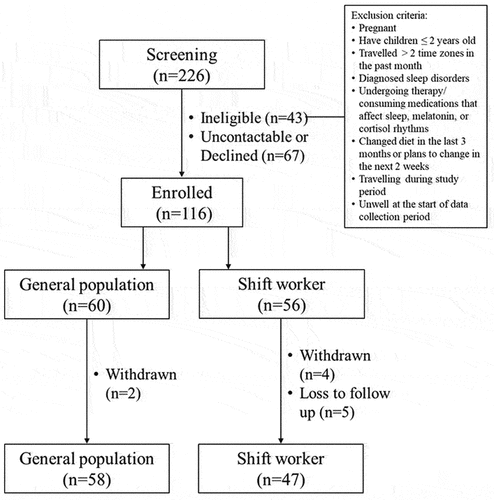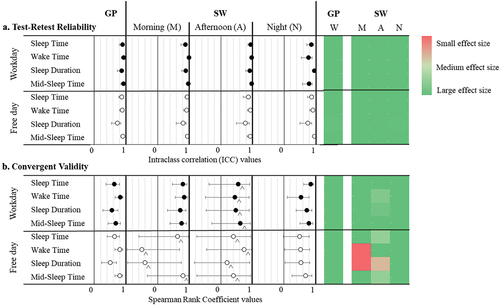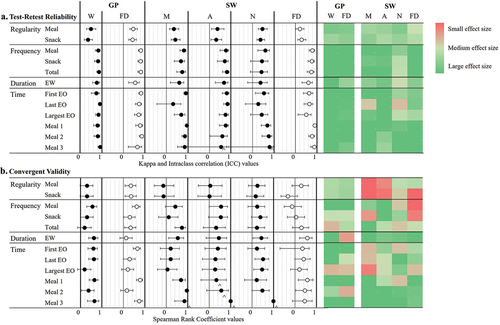Figures & data
Figure 1. Flow diagram of individuals who underwent screening, enrolment, and completed the study, including exclusion criteria.

Table 1. Data sources and variables included in analyses. A shift worker may perform one or more of: morning shift, afternoon shift, and night shift.
Table 2. Demographic details at baseline. *A shift worker may perform one or more of: morning shift, afternoon shift, and night shift. #Categories for ethnicity were derived from the Australian standard classification of cultural and ethnic groups 2019 (Statistics Citation2019). ^Calculated based on data from the CNQ by splitting MSFSC distribution of the study population in thirds; chronotype could not be calculated for all shift workers as insufficient information was provided about work schedule.
Table 3. Sleep variables derived from CNQ compared to sleep diaries for General Population and for shift workers on morning, afternoon, and night shifts, and their following days off. Columns show mean values from the CNQ and Bland-Altman-calculated mean differences (Diff=sleep Diary-CNQ) and the range of the 95% confidence intervals (CI range=CI upper limit – CI lower limit). Bolded values show results of paired samples t-tests comparing CNQ and diary values that were significantly different, p < 0.05. Sample sizes less than 10 are marked with an ^.
Table 4. Temporal patterns of eating variables derived from CNQ compared to food diaries for General Population. Columns show mean values from the CNQ, Bland-Altman-calculated mean differences (Diff = Food Diary-CNQ), and the range of the 95% confidence intervals (95%CI range = CI upper limit – CI lower limit). Bolded values show results of paired samples t-tests comparing CNQ and diary values that were significantly different, p < 0.05. n/a: Bland Altman analyses and 95% CI not calculated for regularity as it was a categorical variable.
Table 5. Temporal patterns of eating variables derived from CNQ compared to food diaries for shift workers on morning, afternoon, and night shifts, and days off. Columns show mean values from the CNQ, Bland-Altman-calculated mean differences (Diff = Food Diary-CNQ), and the range of the 95% confidence intervals (95%CI range = CI upper limit – CI lower limit). Bolded values show results of paired samples t-tests comparing CNQ and diary values that were significantly different, p < 0.05. Sample sizes less than 10 are marked with an ^. n/a: Bland Altman analyses and 95% CI not calculated for regularity as it was a categorical variable.
Figure 2. (a) Test-retest reliability of sleep variables represented on the left as a box (ICC) and whiskers (upper and lower confidence intervals) plot and on the right as heat map, ranging from dark green (excellent reliability) to red (poor reliability). (b) Convergent validity of sleep variables represented on the left as a box (rs) and whiskers (upper and lower confidence intervals) plot and on the right as heat map, ranging from dark green (large effect size) to red (small effect size). Sample sizes less than 10 are marked with a ^. GP: general population; SW: shift worker; W: workday.

Figure 3. (a) Test-retest reliability of temporal patterns of eating variables represented on the left as a box (Kappa for regularity and ICC for frequency, duration, and time) and whiskers (upper and lower confidence intervals) plot and on the right as heat map, ranging from dark green (excellent reliability) to red (poor reliability). (b) Convergent validity of temporal patterns of eating variables represented on the left as a box (rs) and whiskers (upper and lower confidence intervals) plot and on the right as heat map, ranging from dark green (large effect size) to red (small effect size). Sample sizes less than 10 are marked with a ^. GP: general population; SW: shift worker; W: workday; FD: free day; M: morning shift; A: afternoon shift; N: night shift; EW: eating window; EO: eating occasion.

Supplemental Material
Download PDF (716.4 KB)Data availability statement
The data that support the findings of this study are available from the corresponding author, YYP, upon reasonable request.

